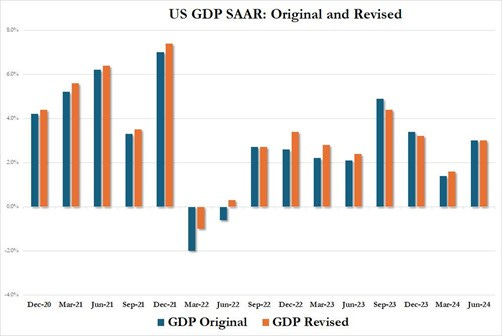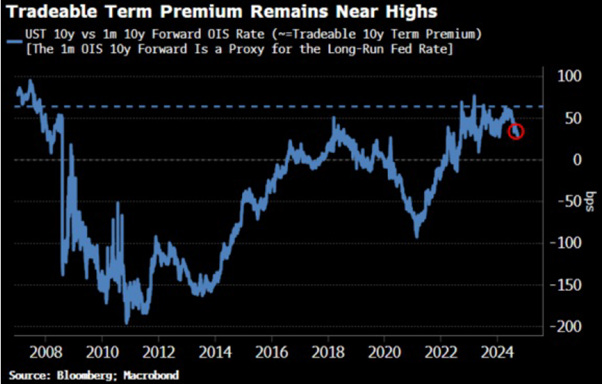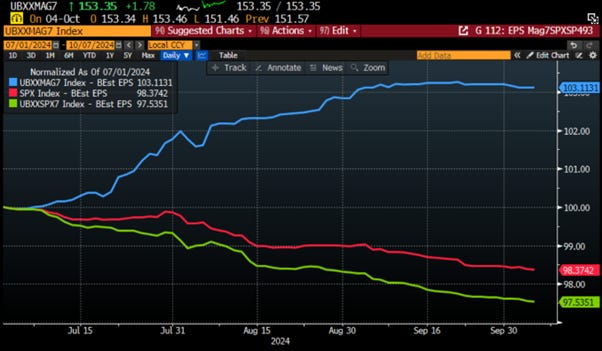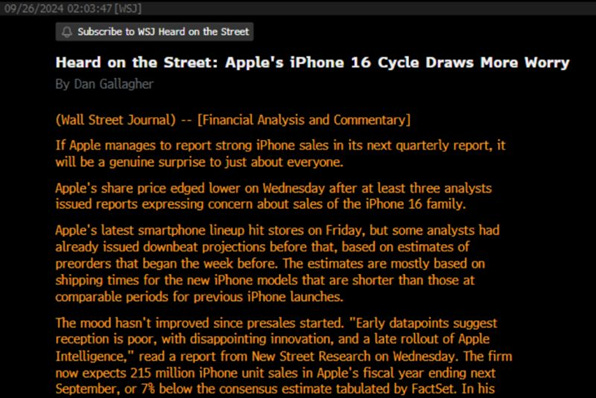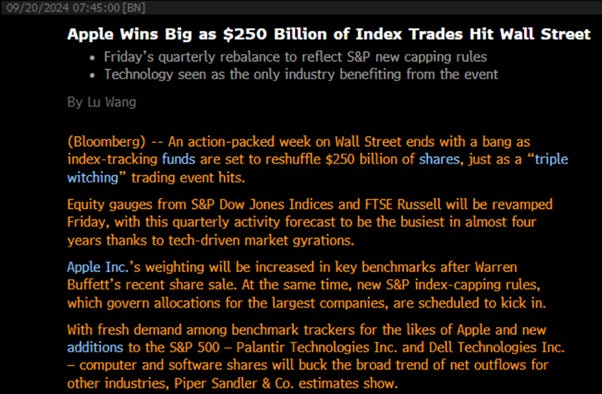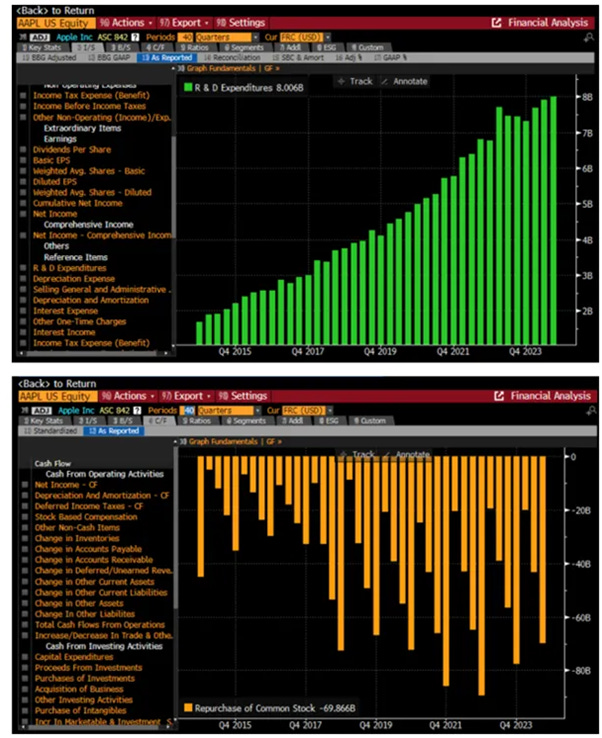Reflation; Rotation & A Rotting Apple
As the year of political hell is still unfolding, September 2024 will be remembered in central bank history as the month with the fastest pace of rate cuts since the Covid crash in April 2020. This likely suggests that those PhD-holding central bankers, much like US corporate insiders and outstanding stock pickers such as Warren Buffett and Stan Druckenmiller, know something that We the People do not, or are not yet allowed to know. In the US, by dramatically dropping rates just 7 weeks before what is expected to be the most contested presidential election in US history, and most likely the last election for the US as we know it, the FED has decided to play with fire. Indeed, given the prevailing dichotomy between the blue and the red, a civil war may be inevitable, splitting the country between the 'United Socialist America' under 'Kamunism' and a 'Lone Star' nation under 'In Capitalism We Trust.'
Regardless of the countercyclical motives put forward by the FED Chairman, it’s a move which was deeply political and partisan, inviting resentment and retribution. Indeed, anyone with a basic knowledge of macroeconomics knows that first rates are not tremendously high in real terms. The inflation fight of the last two years seems to have slowed the rate of price increases, though the battle is far from over.
FED Fund Rate (blue line); US CPI YoY Change (red line); Spead FED Fund Rate – US CPI YoY Change (green line); Correlations & US Recessions.
Despite the prevailing inflation-driven misery for the majority of consumers and adding to the 'Powellian' decision to cut rates on September 18th, the politically and partisan-driven Bureau of Economic Analysis, run by Gina Raimondo, who notoriously supports the previous Bidenomics policies, soon to be renamed 'Kamunism', announced remarkably higher revisions of GDP data since 2020, with the exception of H2 2023.
The massive upward revision of GDP was largely due to the Excel spreadsheet run by Gina Raimondo, who recently also admitted being unfamiliar with how the Bureau of Labor really functions while it had just cut over 800K jobs. Two critical data sets propping up the US economy were revised: personal income and personal spending. Disposable personal income was revised 3.8% higher to $21.8 trillion, while personal spending rose 1.7% to $20.7 trillion. This revision doubled consumer savings from $600 billion in July to $1.1 trillion in August, making Americans appear half a trillion dollars richer, if only in a government spreadsheet.
In a nutshell, despite record credit card balances and various Federal Reserve estimates showing that all the Covid-era excess savings have already been spent, the Orwellian Bureau of Economic Analysis has just proclaimed that, supposedly thanks to 'Bidenomics,' Americans are richer and spending more, even as most US retailers have posted disappointing earnings in the past quarter and consumer related companies like Nike last week issued grim guidance for the rest of the year. Moreover, despite this supposedly healthy economic environment, the FED had to initiate an interest rate cut cycle, its largest since the onset of the Covid lockdowns in March 2020.
Anyone who has studied Economics 101 knows about the Taylor Rule. The Taylor Rule can be summarized as a monetary policy guideline that suggests how central banks should adjust interest rates in response to changes in inflation and economic output. Introduced by economist John B. Taylor in 1993, it has served as the guideline for Federal Reserve monetary policy over the past 30 years.
FED Fund Rate (blue line); Baseline Taylor Rule Estimate for FED Fund Rate (red line); Spread between the FED Fund Rate and the Taylor Rule (lower panel) & US Recessions.
Not only has the spread between the FED Funds rate and the Taylor Rule's estimated rate shown, since the start of the COVID-driven inflation rebound in 2021, how politically behind the curve the FED has been in supporting the Keynesian agenda of the current US administration, but it also indicated that the FED should have raised rates by at least 25 basis points on September 18th rather than cutting them by 50 bps and FED fund rate should be now near 6.0%.
What this all reflects, however, is that a whole lot of nonsense ‘Forward Confusion’ and ‘Forward Illusion’, has been spread, claiming that the misleadingly called ‘Inflation Reduction Act’ is working and that more needs to be done to combat phantasmagorical price gouging. In this context, the world is about to hear that higher corporate and income taxes are necessary to implement ‘Kamunism,’ as climate change and DEI deceptive initiatives supposedly require more funding to make US consumers even stronger and wealthier.
Over the past few weeks, current US Treasury Secretary and former FOMC Chairwoman Janet Yellen trumpeted in various ‘Kamalesque’ interviews that veering off course could jeopardize US economic trajectory. The even more partisan former FED Chairwoman Yellen stated that tax cuts for higher earners 'would explode the federal deficit,' those repealing investments in 'the industries of the future would stunt growth,' and that 'pursuing nontargeted, nonstrategic international economic policies would raise costs for Americans and cause global turmoil.' By spreading further confusion about a phantasmagorical soft landing and the illusion that the US banking sector is sound and well-capitalized, the politically partisan former FOMC Chairwoman and current US Treasury Secretary continues to mislead everyone about the harsh reality of the US economy and its banking system.
While anyone with common sense who has followed Warren Buffett's recent decision to methodically exit his stake in Bank of America, which is technically insolvent and has moved from being too big to fail to too big to rescue, might find it likely that the US Treasury Secretary is still high on the magic mushrooms she brought back from her latest trip to China, where she went to beg the Chinese government for more money to lend to the US government to buy bullets to shoot at the Chinese in the next inevitable developments of the US' forever wars.
Coming back to the September FED rate cut, to get ahead of a potential recession, the FED is expected to engage in another round of easing. However, the reality is that recessionary conditions are evident everywhere except in official reports. Bankruptcies are high, inflation is underestimated, and growth is overestimated, a fact known to those in the know. Additionally, many are unaware that the money supply is already increasing due to relaxed lending standards and more debt purchases by the FED. This, combined with rising money velocity after the risk aversion of the lockdown years, is fuelling price pressures. Whether this manifests in the retail sector or financials, it reflects not true economic growth, but an illusion created by monetary depreciation.
With the FED easing, investors should consider the consequences of this politically driven monetary decision, reminiscent of what Western institutional investors once derisively called a 'banana republic.' The FED kicked off its rate-cutting cycle with a significant 50 basis point reduction, yet financial conditions are almost at their loosest ever at the start of easing. Excess liquidity remains strong and is poised to strengthen further, while long-term inflation risks are likely to rise rather than recede. Excess liquidity, the gap between real money growth and economic growth, is a key medium-term indicator of risk-asset performance. G10 excess liquidity leads global assets like US stocks by about six months, having notably increased since the first quarter of 2023. This trend has been a strong signal that, outside political interventions, the stock market’s long-term path of least resistance remains upward, despite surrounding noise.
At this stage in the cycle, after multiple global rate increases, one might expect excess liquidity to weaken. Instead, it is experiencing one of its largest two-year accelerations in 50 years, and this trend may continue. Two factors are driving this strengthening: easier monetary policy worldwide, likely spurred by most of the G10 central banks pre-empting the recent FED’s easing, and recent monetary and fiscal stimulus from China. Excess liquidity is a straightforward concept: money created by banks and central banks that isn’t absorbed by inflation or economic growth is considered 'excess' and can flow into risk-asset markets. While excess liquidity collapsed as global central banks raised rates to combat inflation, it has revived as central banks around the world, including the FED in 2023, have utilized shadow liquidity to keep their financial systems afloat, avoiding the dire consequences of bank runs in US regional banks.
The recent Federal Reserve’s significant rate cut will increase price and liquidity risks for longer-dated Treasuries by heightening inflation volatility and term premium, leading to further bear steepening of the yield curve. Milton Friedman often critiqued central banks, using the metaphor of the ‘fool in the shower’ to illustrate how they set monetary policy. Adjusting policy is like adjusting a shower’s hot and cold controls without realizing there’s a lag between turning the tap and the water temperature. By cutting rates by 50 basis points and potentially more later this year, the FED risks overstimulating the economy when inflation does not warrant it and remains supply-driven rather than demand-driven. The term premium on longer-dated Treasuries is expected to rise, and liquidity risks, already exacerbated by large fiscal deficits, are likely to worsen. The yield curve is expected to maintain a bear-steepening bias in a context where more and more investors realise that the once upon a time risk free asset (i.e. US Treasury) is no more free of risks. Inflation and its variance pose significant risks for longer-maturity bonds, as inflation volatility tends to increase more after the FED cuts rates than during rate hikes or periods of stability.
Indeed, while it’s typical for the curve to steepen after the FED begins easing, the bear steepening is likely to prevail due to liquidity and inflation risks boosting longer-term yields. Inflation and the uncertainty surrounding its trajectory are reflected in the term premium, a non-tradable measure that quantifies the extra yield bond buyers demand for holding longer-term debt. On average, the term premium tends to rise after the FED cuts rates, unlike after rate hikes or holds, when it trends lower or remains stable.
The term premium is biased higher not only when the FED cuts rates, but also in relation to the magnitude of the market's surprise from the cut. Additionally, there is a significant positive relationship between the size of the FED’s surprise and the yield curve, with larger surprises resulting in steeper curves.
September’s half-point cut marked the biggest downside surprise outside of crises in the past 20 years, indicating the FED cut more than expected. However, such a significant move will not solve the economic problems, which are all related to reckless government spending and shortages that will only worsen as the global war cycle heats up in the coming months. While the consensus is looking for more 50 basis-point cuts, the FED won’t be able to deliver them as the economy remains impacted by wars and tighter regulations, which are inflationary in nature. This increases the likelihood of upward surprises in rates, meaning the FED cuts less than the market anticipates, which could raise the term premium and push long-term yields higher. The perfect storm for these yields includes greater uncertainty, lower rates fuelling structural inflation risks, and negative impacts on risk assets. The FED’s rapid cuts will indeed be unable to deliver their intended impacts on the real economy, and as excess liquidity has been rising strongly since early 2023, it has supported risk assets and maintained loose financial conditions despite significant rate increases.
In this context, liquidity in the Treasury market faces a challenging outlook due to rising inflation volatility and term premium. Bloomberg’s Treasury Liquidity Index recently hit new highs, indicating poor liquidity, and while it has since declined, it remains elevated compared to most of its 15-year history. Some of this increase may stem from illiquid 30-year bonds issued during the late 1990s budget surplus, which trade expensively against the fitted yield curve, pushing the liquidity index higher. Nonetheless, liquidity risks are expected to rise again as the FED’s easing heightens inflation volatility.
Rising inflation risks are challenging enough for the Treasury market, especially as the government faces annual fiscal deficits of $1.5 to $2 trillion, expected to persist for at least the next decade. A rapid increase in bill issuance over the past two years has mitigated the burden of the duration the market needed to absorb for the government’s increasing borrowing requirements. However, bill issuance is levelling off, while bond issuance is rising, resulting in an inevitable significant increase in duration.
There is no guarantee that the market will continue buying longer-term Treasuries at current prices while the government borrows heavily and the FED increases inflation risks. As a result, the term premium is likely to rise as the market demands a greater margin of safety for holding government debt. Although term premium is untradeable, it can be approximated by examining short-term OIS rates far forward (e.g., the one-month rate, 10 years ahead) to gauge the market's long-term view on the short rate. The difference between this rate and the 10-year yield provides a tradeable version of the term premium. Currently, this premium is near recent highs, comparable to those seen during the Global Financial Crisis (GFC), and with the FED amplifying risks, we could soon see those highs surpassed.
Adding to the reflation threats related to the politically and partisan-driven FED rate cut in September will be the recent stimulus launched by China, which is likely to accelerate the return of the inflation boomerang in the US and across the Western world. Indeed, the San Francisco FED breaks down core PCE into cyclical and acyclical components. Cyclical components are those that are highly correlated to FED policy, while acyclical components are what remains. Over the past 24 months, it appears that the bulk of the disinflationary illusion of the core PCE has been driven by the fall in acyclical PCE, as core PCE is still at 40-year highs. Unsurprisingly to anyone with a basic knowledge of economics, acyclical PCE has tracked the ups and downs of PPI in China well over the past two decades.
In layman terms, the recent monetary and fiscal stimulus announced by Xi Jinping seems like a poisoned gift for whoever becomes the next president of the United States and for the FED Chairman, who, in front of the Mountain of Wyoming, declared ‘mission accomplished’ against inflation to justify his partisan monetary policy, without realizing that the Chinese could play their tricky card against him sooner than expected.
Interestingly, since the last FOMC meeting on September 18th, the bond market has witnessed the return of the bear steepener, with yields across the US Treasury curve rising between 20 to 25 basis points, with the largest increase occurring at the long end of the curve.
From a macroeconomic perspective, the inevitable return of the inflation boomerang will come at the same time of the re-steepening of the yield curve (the difference between the US 10-Year and 2-Year yields). While some will continue to claim victory in the fight against inflation until the political circus around the White House is over, the reality is that the year-over-year change in the US CPI is likely to rebound once the political circus surrounding the White House concludes, regardless of who occupies the Oval Office next.
US CPI YoY Change (blue line); US 10-Year Yield-US 2-Year Yield (histogram); Correlations and US recessions.
The past six months have been tough for those opposing the narrative from governments, central banks, and Wall Street that inflation is no longer a concern. However, the inflationary secular themes of the 2020s persist, including trends toward big government, inequality to inclusion, monetary to fiscal policy, leveraging to deleveraging, globalization to isolationism, peace to war, advancements in AI, net zero goals, and aging demographics. These shifts are evident in the 10-year rolling returns across asset classes. Despite the media's push for investors to pursue the duration trade, US Treasuries are still on track for their worst decade of returns in the past 125 years.
With the shift in the FED's inflation target from a ceiling (2009-2020) and an average (1994-2008) to a floor, the Summary of Economic Projections indicates that the PCE is expected to hover around 2.5% in the near future. Since the CPI typically exceeds the PCE by over 40 basis points, the FED is effectively aiming for a minimum inflation rate of 2.4% or higher. Thus, if the FED achieves this target, the average inflation rate for the next 12 months could reach approximately 2.9% at best, as the base effects reverse.
US CPI YoY Change (blue line); US 10-Year Yield (red line); US Core PCE YoY Change (green line).
Since all financial assets are still priced based on a 2% CPI, the bond market is on the verge of a massive repricing due to the FED's new inflation target assumptions.
In this context, it is evident that the FED is not managing the Federal Funds rate for the benefit of the American people but rather to facilitate the upcoming refinancing cycle of the US government and support the financial sector. Many of its largest players are effectively insolvent, grappling with unrealized losses not only on government bonds but also from rising defaults in commercial real estate and other mortgage-backed securities on their balance sheets.
United States of America Debt Distribution.
The FED has effectively established a cartel-like arrangement among banks, transforming them from products of free enterprise into a privileged monopoly that serves its member banks and the government. The FED's creation directly facilitated the funding of World War I, and the problem has only worsened over time. Unlike state governments, which must fund expenditures through tax revenue or debt subject to default risk, the US federal government operates without such limits. Its bonds are treated as cash primarily due to the FED's ability to print money in times of crisis. For those sceptical about the FED's role as a tool of Wall Street, RFK's remarks during a late September campaign rally underscore its impact on wealth and the need to address the issues stemming from the Washington swamp.
In simple terms, the FED acts like a pump that supports the ‘too big to fail’ banks, which have now become ‘too big to rescue.’ It's no surprise that the politically influenced FED chair has chosen to focus on managing the upcoming funding crisis instead of tackling inflation.
In a nutshell, for bond investors, the upcoming reflation of the economy and the FED's confirmed actions combined with a 'supply-driven' bearish outlook for US Treasuries in a world where USD assets have been weaponized, mean that the US 10-year yield hit a floor on the same day as the infamous FED pivot, with 3.5% now serving as the new floor and resistance expected between 5.0% and 6.0%, likely to be reached once the political circus surrounding the White House is settled.
As the third quarter of 2024 will be remembered in FED history as the quarter of the notorious post-Covid pivot, equity investors should note that 2024 will mark the highest P/E ratio at the start of a FED cutting cycle in over 60 years.

For equity investors, the third quarter can be summarized in one line: new highs, different reasons. While the S&P 500 and Dow Jones reached new all-time highs in September, the Nasdaq did not, indicating a shift in market character without altering its overall direction. Market breadth has been excellent. Amid the prevailing belief that the fight against inflation has been accomplished, strength in equities has stemmed from sectors like Utilities; Real Estate and REITs, which benefit from lower rates.
Despite bullish sentiment prevailing around Wall Street, since the Nasdaq's peak on July 10th, the so-called Magnificent Seven has significantly underperformed the S&P 500 which simultaneously lagged behind the S&P 500 equal-weighted.
Year-to-date relative performance of Magnificent 7 to S&P 500 Index (blue line); relative performance of S&P 500 index to S&P 500 equal weight index (red line).
In this context, the Magnificent Seven may soon become the Abysmal Seven. As the new earnings season approaches, a quick look at earnings revisions reveals that analyst, known for being followers rather than forecasters, have yet to acknowledge the market's signals regarding the increasingly misleadingly called Magnificent Seven. Indeed, since July, EPS revisions for the Magnificent Seven have continued to outperform those for the entire S&P 500 and the other 493 stocks in the index.
EPS revisions since July 1st 2024 of Magnificent 7 (blue line); S&P 500 index (red line); S&P 493 index (ex Magnificent 7) (green line).
It should therefore be no surprise that YOLO investors and illiterate fund managers, spending their time listening to misleading analysts and financial media rather than doing research on their own, are still pouring money into tech funds, which have dominated and continue to dominate year-to-date flows, while outflows have been concentrated in Healthcare and Energy.
A quick look at the performance of the supposedly Magnificent 7 since the Nasdaq peak on July 10th shows that only META outperformed the equal-weighted S&P 500 index during that period. META, which is notoriously collaborating with those in power at the White House to impose greater technological censorship, has been the only Magnificent 7 which delivered a positive return since July 10th. All the other Magnificent 7 have posted negative returns over that time frame.
One member of the Magnificent 7 that is likely to become the next Abysmal 7 after Tesla is Apple. Savvy investors have probably started realizing that the company has primarily been propping up its share price through share buybacks rather than boosting earnings per share through innovation. With management more focused on DEI initiatives and LGBTQ-themed presentations, the Wall Street Journal noted recently that ‘If Apple manages to report strong iPhone sales in the next quarterly report, it will be a genuine surprise to just about everyone.’
Indeed, only 55.4% of Apple iPhone users plan to upgrade in the next 12 months, down from 59.9% last year and 63.5% two years ago, according to a Bloomberg survey. This decline suggests that users are keeping their phones longer due to improved device quality, high prices, and limited hardware innovation. Furthermore, 23.1% of respondents are not planning an upgrade, up from 15.9% two years ago, indicating unsurprising pressure on consumer spending.
Recent survey findings also show shorter lead times for iPhones, with the Pro Max model's delivery down to 26 days from 33 last year and the base iPhone 16 to 7 days from 14. While this may reflect better supply management, it is most likely reflecting demand weakness. Therefore, achieving the consensus expectation of 235 million units sold in 2025 and an 8% growth in iPhone sales seems unrealistic.
Sentiment around ‘Apple Intelligence’ has remained unchanged since the June survey, despite the company’s strong marketing efforts. Among those considering an earlier upgrade, AI features ranked last as a motivation, with storage and processing speed being the primary reasons. Only 16.3% cited AI features as a reason for upgrading, consistent with the June findings.
At the same time analysts, notoriously known as price manipulators rather than providers of honest stock advice, are flip-flopping on Apple, JPMorgan’s team, led by Samik Chatterjee and Joseph Cardoso, shifted their stance within days. On Sept. 27, they noted ‘slower initial demand for Pro models’ in a client note, suggesting it was a temporary issue. Yet, by October 1, the same analysts issued a new note, ‘Near-term Upside Likely Limited with AI Availability the Gating Factor,’ highlighting limited upside despite maintaining AI-upgrade cycle expectations.
The scandalous investment bank is probably attempting to manipulate Apple's share price to help one of its biggest clients offload stocks at a favourable price to YOLO investors who trade based on headlines. In this context, it's important to remember that Berkshire Hathaway reduced its Apple holdings to just 2.6% after halving its stake in Q2 2024, meaning Warren Buffett can quietly and gradually sell more shares without drawing media attention while at the same time, the complicit financial media continues to push the narrative that the ‘Magnificent 7’ are leading the US economy to a phantasmagorical soft landing, which has already shifted to a gloomy inflationary bust.
Interestingly, following the sale of Berkshire’s stake in Apple, the company's representation in index-tracking funds has increased. This means passive investors had to buy shares to reflect its growing weight, even as the best stock picker in financial history is divesting. In short, passive investors have been compelled to buy what Warren Buffett is selling.
All investors are already aware that Apple has become a DEI-driven hedge fund, propping up its share price through share buybacks rather than innovation, as it's well known in the investment community that over the past 10 years, Apple has spent nearly 10 times more on buybacks each quarter than on R&D.
However, while Apple has been a major winner in the latest quarterly adjustments of major stock indices, it has underperformed both the S&P 500 and Berkshire Hathaway since Warren Buffett announced the sale of half his stake in mid-July which also, unsurprisingly, coincided with the peak of the Nasdaq. This has led to speculation that, like other prominent stock pickers, Warren Buffet may be using these passive index readjustments to sell more shares.
Year-to-date relative performance of Apple to S&P 500 index (blue line); relative performance of Apple to Berkshire Hathaway (red line) & Apple daily trading volumes.
In today's dystopian landscape of passive investing, not investors are forced to buy more of what Warren Buffett sells but also, they are forced selling what he and other insiders are buying. Compounding this issue is the rise of ESG investing, which has dominated financial markets in recent years. For example, while over half of insurers have reduced their investments in fossil fuel producers, Berkshire Hathaway reported spending $39.9 billion on oil and gas securities last year, increasing its fossil fuel investments to over a fifth of its total $183 billion portfolio.
All these dystopian equity flows coincide with the world entering a new war cycle, which will inevitably result in further supply-driven shortages in commodities. The impact of the war cycle can already be observed in the 10-year rolling return of commodities which is recovering from its worst decade since the 1930s, a period when the world similarly attempted to ignore the looming threat of a global conflict.
Over the past decade, the prevailing narrative on Wall Street has been to stop panicking when central banks do. Consequently, the question on every investor's lip is whether to chase the market rally or not.
Investors should avoid chasing the market in the short term as here is October, a month known for significant volatility in election years.
This is particularly true when considering the potential outcomes of the 2024 election. According to betting markets, which tend to be more accurate than politically driven polls, the three most probable scenarios for November 5th are: a Republican sweep, a Democratic president with a Democratic House and a Republican Senate, and a Democratic sweep. The latter two scenarios, with around 49% probability as of now, would lead to the implementation of "Kamunism" (higher corporate taxes, price controls, and taxes on unrealized gains), representing the worst outcome for equity investors.
Given that this election is likely to be the most contested in US history, potentially triggering civil unrest and signalling the beginning of the disintegration of the United States as we know it, volatility is expected to rise significantly, likely surpassing the year-to-date high recorded during the 'Yen Carry Trade Tantrum' in early August. This heightened volatility could persist until the next occupant of the White House is officially confirmed on January 6th, 2025.
S&P 500 index (blue line); Chicago Board Options Exchange Volatility Index (VIX Index) (axis inverted; red line) & Correlations.
Ultimately, investors should remember that as rule number 5 of the famous Bob Farrell, the public buy the most at the top and the least at the bottom.
As most insiders and top stock pickers are reducing their equity exposure, it seems the public is making a familiar mistake that undermines sustainable performance over equity cycles: buying the most at the peak while others wait for a bottom. Ironically, the same YOLO investors who are buying now will likely be the ones buying the least when the market hits its lows.
SPDR S&P 500 ETF (SPY) & Cumulative Money Flow since 31st December 2019.
Read more and discover how to position your portfolio here: https://themacrobutler.substack.com/p/reflation-rotation-and-a-rotting
If this report has inspired you to invest in gold and silver, consider Hard Assets Alliance to buy your physical gold:
https://hardassetsalliance.com/?aff=TMB
At The Macro Butler, our mission is to leverage our macro views to provide actionable and investable recommendations to all types of investors. In this regard, we offer two types of portfolios to our paid clients.
The Macro Butler Long/Short Portfolio is a dynamic and trading portfolio designed to invest in individual securities, aligning with our strategic and tactical investment recommendations.
The Macro Butler Strategic Portfolio consists of 20 ETFs (long only) and serves as the foundation for a multi-asset portfolio that reflects our long-term macro views.
Investors interested in obtaining more information about the Macro Butler Long/Short and Strategic portfolios can contact us at info@themacrobutler.com.
Unlock Your Financial Success with the Macro Butler!
Disclaimer
The content provided in this newsletter is for general information purposes only. No information, materials, services, and other content provided in this post constitute solicitation, recommendation, endorsement or any financial, investment, or other advice.
Seek independent professional consultation in the form of legal, financial, and fiscal advice before making any investment decisions.
Always perform your own due diligence.
NEVER MISS THE NEWS THAT MATTERS MOST
ZEROHEDGE DIRECTLY TO YOUR INBOX
Receive a daily recap featuring a curated list of must-read stories.
Trending on ZeroHedge
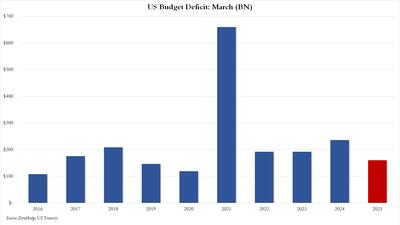
March Deficit Unexpectedly Tumbles To 5 Year Low As DOGE Cracks Down On Democrat Money-Laundering Schemes

These Are Most Common Types Of Fraud In America






